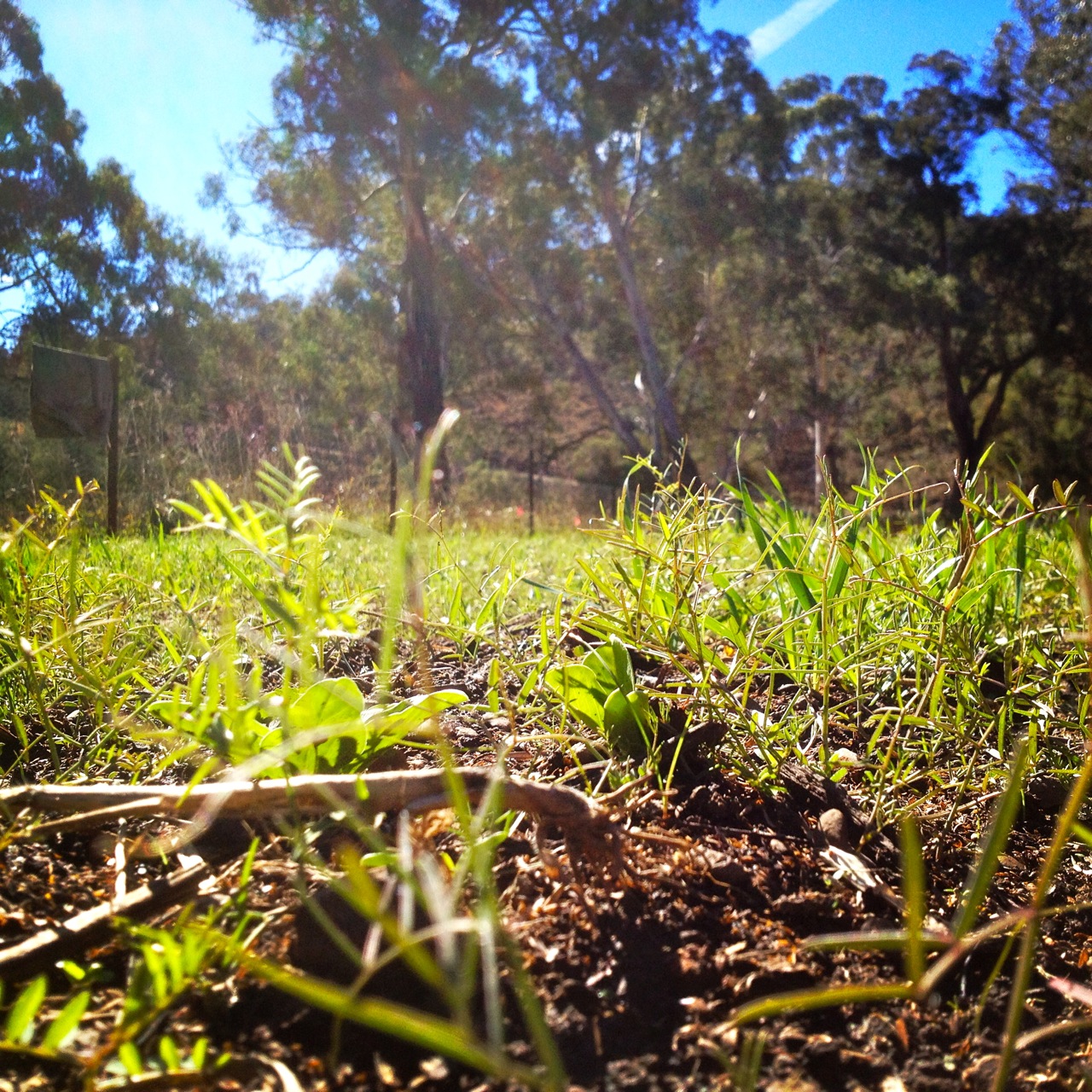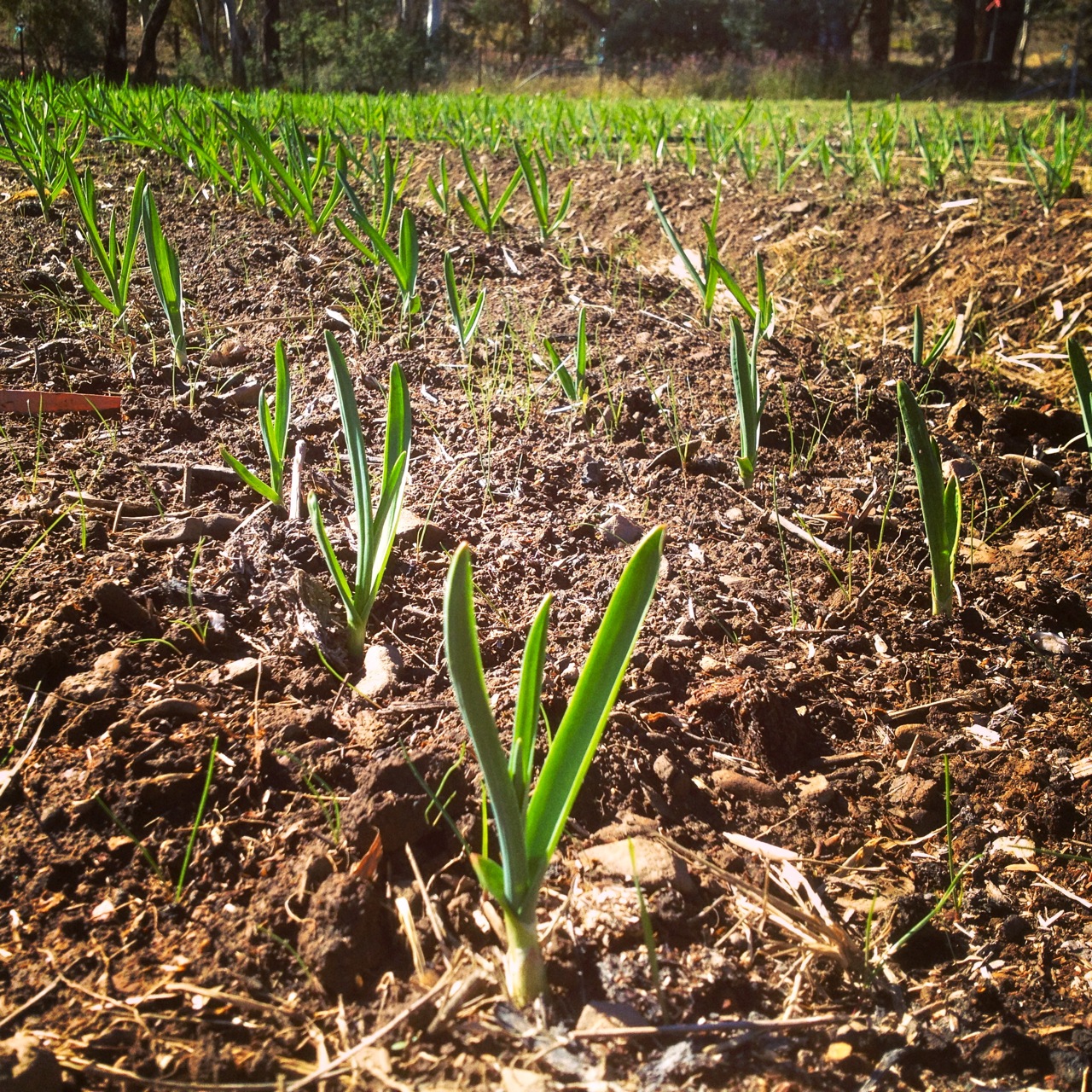After a fabulous summer of yielding buckets apon buckets of organic veggies, our market garden needs a rest. This system is a cycle of give and take, and it is definitely time to go into a giving phase for our not-that-brilliant soils.
Also, Michael’s been having ideas. It’s re-design time. We’re two seasons in from the start of this veggie growing project, and we’ve all agreed it’s time to get funky. Designing for resilience, you might call it…

The market garden 2 days later. Somewhat different, and in the middle of being ripped. But Michael was happy…
The first step in this re-design is to get our soils as happy and healthy as they can possibly be, given our land and climate and resources. We’ve ‘mined’ these soils for nutrients over the summer in the form of vegetables that have grown here, and that we’ve picked and eaten.
While we’ve been giving plenty back to our soils over summer in the form of compost and biofertilizers, we want to create really great soils on our creekflat, not just she’ll be right soils. This is our farm’s little food bowl. It’s what gives our bodies 80% of our nutrients.
Also, there’s the weather. Ah yes, that. Now considering my little rant about doing what we can in the face of climate change, it’s time to get designing for the future. So we can get on with living it. Preferably with a beautiful year-round supply of amazing food for us and everyone who comes to the farm.
So. Planning for resilience. Planning for crazy weather patterns. Planning for drought. Planning for flood.
Yep, I know you’re with me – it’s time to perennialise the crops in the market garden. Bits of it, anyway.
So we’re thinking (and Michael is currently designing) to create a quasi row-based, simplified forest garden system with annual beds in between, starting this Spring. There will be high-yielding fruit trees. There will be understorey pick-n-mix type greens. And there will also be rows of normal annual vegetables in there too.
This is an interesting trajectory, given that 2 years ago we decided to veer away from the widely espoused permaculture ‘polyculture bed’ method of growing, at least in our market garden. And I’m glad we where we did. We managed to grow bulk veggies via intensive, organic agriculture, on a small piece of land.
Now, though, we’re progressing the garden to provide what we need, and what we want. Which is more staples, for more of the year, in the face of more possible variances of climate.
What we won’t have is 1/2 acre of annual veggies, all at the mercy of the next big dry (or next big wet). What we will have is a resilient food growing system that swaps variety for the most suitable veggies, berries, tubers and tree crops for our climate (and it’s projections), that we can grow in the best soils we have at Milkwood.
Also, it means more rhubarb. What could possibly go wrong?
So – first things first. Soil fertility.
Unless you have the budget to source tonnes and tonnes of excellent compost and truck it all in, or a large mob of attendant cows (wouldn’t that be great – maybe one day), soil fertility is necessarily a DIY affair with soils like ours.
While our composting systems have yielded massive piles of goodness, we need more nutrient inputs to account for our large amount of veggie outputs.
So green manure crops are crucial here, on top of the compost and the biofertilizers and the seaweed extract and the rock dusts and the chicken manure and all the rest.
As this garden space is in overhaul, we decided now was a good time to rip it. With a sub-soil plow, which will break up the hard-pan in the sub soil, while not upturning the topsoil. This way we don’t turn our soil food web upside down, but we do get some de-compaction.
Sub-soil plowing is not something to be done every year. Infact we may not ever do it again. But in the interests of fast-tracking this garden and its attendant tree crops, rather than waiting the extra 5 years for the tree roots, daikon radish and all the rest to de-compact the sub soil, we brought in the ripper.
And we only broke the tractor once in the process – hoorah! The gearbox popped out. Presently it got popped back in again, and we finished the job. Gotta love the judicious use of fossil fuels and heavy machinery occasionally.
Next step – green manure cover crop – over everywhere. Michael broadcast a mix of inoculated vetch, oats, clover, lucerne and brassicas, and then raked it all in so the birds couldn’t get to it all.
This green manure mix will provide a combination of nitrogen fixation (via the vetch, clover and lucerne) and green biomass which will then be ‘dug in’ in Spring. By spring planting, this soil should be pretty darn happy.
Of course, it helps if autumn rain arrives to help germinate the seeds. Which the rain duly did not. And so it was time for sprinklers.
Michael set up big sprinklers across the entire market garden. Normally we wouldn’t use these for watering, partly as they make everything (including the weeds) grow, rather than the specific plants we’ve set in. But in this particular context, that was the idea. Grow, everything, grow…
And now the market garden is a green carpet. It would be much greener if we’d had any rain in the last three months, just for the record. So this is what several weeks of conservative overhead watering looks like, at this time of year, at Milkwood.
In a corner of the market garden, down the western end, Michael’s also planted out our year’s garlic supply, which has all come up and is looking truly cheerful. We’ve moved this crop’s growing area from a patch below the chicken run to the main market garden.
The reason for this is to get all the high-value food crops close together – we’ve decided that, overall with a climate and on a site like ours, it’s best to concentrate as much of our high-need (read: needs more than watering every other month) crops on the flat, for now.
This way, we all see them every day and we know they’ll get weeded and watered as much as they need. And coddled, if necessary, depending on the needs of the season.
This last point might seem like a no-brainer to those on small or flat blocks… but if you’re growing on a hilly site where this crop is here and that crop is way over there and there’s a nook of this and a nook of that… well, sometimes things don’t get seen to the day that they should. Because we’re all busy, and they’re not right there.
So. In the interests of efficiency, we’re condensing our food crops to the creekflat. Mostly. Apart from the hill and dehesa plantings, which are another story again.
The frosts have arrived, now, so the growth of the green manures will slow down a fair bit. But they’ll continue to grow through the winter and come spring will have converted much sunlight into goodness for our garden and the future crops we’ll be feeding everyone with next Spring…
>> More posts about market gardening at Milkwood farm
Big thanks to Rob Laurie for the subsoil plow, to Karl for the tractor, and to everyone who helped get the green manures in. And to Michael for keeping his creative and problem-solving approach firmly fastened in all weathers.

















Nice work! I’m keen to follow this little journey. Speak soon.
I’m wondering of you’ve looked into biochar as a way to increase your soil’s nutrient- and water-holding capacity…..for decades….heck, for centuries in the case of terra preta in South America.
yep, we’re experimenting with that also 🙂
have you found your permaculture design shifting or changing in any way?
change is the constant! Observe, interact and adapt 🙂
Funny as soon as I saw the plough I thought biochar as well! Guess Nancy beat me to it. 😀
Thanks so much for sharing both your thought process and practical approach here. Redesigning as needs and circumstances change is so important! Inspiring and informative as always… and yes, with garlic and rhubarb laid on, life ain’t bad at all 🙂
It’s been third time lucky with this autumn’s planting (the first two hoped-for ‘breaking rains’ having failed to eventuate in Adelaide). Hope a bit of wet (and not too much) reaches you soon!
Interesting your going that way because I have been growing most of my annual veg inbetween my rows of perennials (blueberries, raspberries, jostaberries, etc) and I reckon its a goer! Ive toyed with the idea of doing it inbetween larger fruit trees too. Shade is an issue but can also be an advantage for many annuals.
Have been thinking along similar lines here! Looking forward to seeing the design take shape 🙂
Actually the plants are using the sun’s energy to make new organic matter primarily from the air! Maybe that’s what you meant by “converting sunlight to goodness” but I know alot of people think that plants build thir mass out of sunlight or soil, so I like to share when I hear stuff like that. (I’m a science teacher.) Thank you for your inspiring chronicles!
I so love your site! I’m a market gardener and so i love reading about the thinking you do about soil fertility etc…..I also saw the soil blocker on your site and have now ordered one..thank you! I had become a little too dependent on an old guy who grows trays of excellent seedlings for my garden, I heard with dismay that he is retiring so time to get to work on my own….Would love to do some of your courses but I’m a bit far away to make that practical. Anyway just love what your doing and that you… Read more »